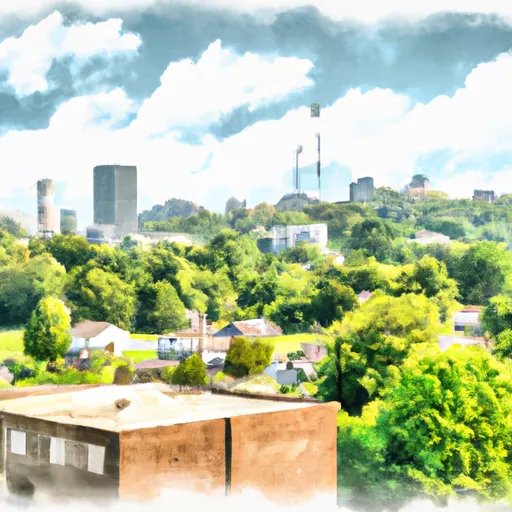-
 Snoflo Premium
Snoflo Premium
Get unlimited access to all our content
With no Ad interruptions! - Start Your Free Trial Login with existing account
Woodlawn
Eden Index
Climate
7.9
•
Recreation
3.1
•
Community
0.7
•
Safeguard
4.4/10

Woodlawn, Tennessee is a small town located in Montgomery County. The climate in Woodlawn is classified as humid subtropical, characterized by hot summers and mild winters. Average temperatures range from around 30°F (-1°C) in winter to 90°F (32°C) in summer. Precipitation is evenly distributed throughout the year, with an average annual rainfall of around 50 inches (127 cm).
Hydrologically, Woodlawn is situated in the Cumberland River Basin, which provides a diverse range of aquatic habitats. The Cumberland River offers opportunities for boating, fishing, and water sports, with a variety of fish species such as bass, catfish, and crappie.
For outdoor enthusiasts, Woodlawn offers several recreational opportunities. Dunbar Cave State Park, located nearby, boasts over 144 acres of natural beauty, including hiking trails, picnic areas, and a lake for fishing. The park is home to Dunbar Cave, one of the largest caves in the United States, offering guided tours to explore its fascinating geological features.
In summary, Woodlawn, Tennessee enjoys a humid subtropical climate with mild winters and hot summers. It is located in the Cumberland River Basin, providing hydrological diversity and outdoor recreation opportunities, including boating, fishing, hiking, and cave exploration at Dunbar Cave State Park.
What is the Eden Index?
The Snoflo Eden Index serves as a comprehensive rating system for regions, evaluating their desirability through a holistic assessment of climate health, outdoor recreation opportunities, and natural disaster risk, acknowledging the profound impact of these factors on livability and well-being.
Climate Health Indicator (CHI): 7.9
Woodlawn receives approximately
1305mm of rain per year,
with humidity levels near 84%
and air temperatures averaging around
15°C.
Woodlawn has a plant hardyness factor of
7, meaning
plants and agriculture in this region tend to thrive during the non-winter months.
By considering the ideal temperature range, reliable water supplies, clean air, and stable seasonal rain or snowpacks, the Climate Health Indicator (CHI) underscores the significance of a healthy climate as the foundation for quality living.
A healthy climate is paramount for ensuring a high quality of life and livability in a region, fostering both physical well-being and environmental harmony. This can be characterized by ideal temperatures, reliable access to water supplies, clean air, and consistent seasonal rain or snowpacks.
Weather Forecast
Streamflow Conditions
Lower Cumberland
Area Rivers
Lower Cumberland
Snowpack Depths
Lower Cumberland
Reservoir Storage Capacity
Lower Cumberland
Groundwater Levels
Recreational Opportunity Index (ROI): 3.1
The Recreational Opportunity Index (ROI) recognizes the value of outdoor recreational options, such as parks, hiking trails, camping sites, and fishing spots, while acknowledging that climate plays a pivotal role in ensuring the comfort and consistency of these experiences.
Access to outdoor recreational opportunities, encompassing activities such as parks, hiking, camping, and fishing, is crucial for overall well-being, and the climate plays a pivotal role in enabling and enhancing these experiences, ensuring that individuals can engage in nature-based activities comfortably and consistently.
Camping Areas
| Campground | Campsites | Reservations | Toilets | Showers | Elevation |
|---|---|---|---|---|---|
| Holt Lake | None | 187 ft | |||
| Bells Landing | 14 | 69 ft | |||
| Payne Lake West Side | None | 282 ft | |||
| Lock 5 | None | 99 ft | |||
| Isaac Creek | 60 | 57 ft | |||
| Payne Lake Spillway | None | 267 ft | |||
| East Bank/Millers Ferry | None | 89 ft | |||
| Haines Island | 12 | 55 ft | |||
| Damsite West Bank | None | 63 ft | |||
| Payne Lake East Side | None | 362 ft |
Nearby Ski Areas
Catastrophe Safeguard Index (CSI):
The Catastrophe Safeguard Index (CSI) recognizes that natural disaster risk, encompassing floods, fires, hurricanes, and tornadoes, can drastically affect safety and the overall appeal of an area.
The level of natural disaster risk in a region significantly affects safety and the overall livability, with climate change amplifying these risks by potentially increasing the frequency and intensity of events like floods, fires, hurricanes, and tornadoes, thereby posing substantial challenges to community resilience and well-being.
Community Resilience Indicator (CRI): 0.7
The Community Resilience Indicator (CRI) recognizes that education, healthcare, and socioeconomics are crucial to the well-being of a region. The CRI acknowledges the profound impact of these elements on residents' overall quality of life. By evaluating educational resources, healthcare accessibility, and economic inclusivity, the index captures the essential aspects that contribute to a thriving community, fostering resident satisfaction, equity, and social cohesion.

